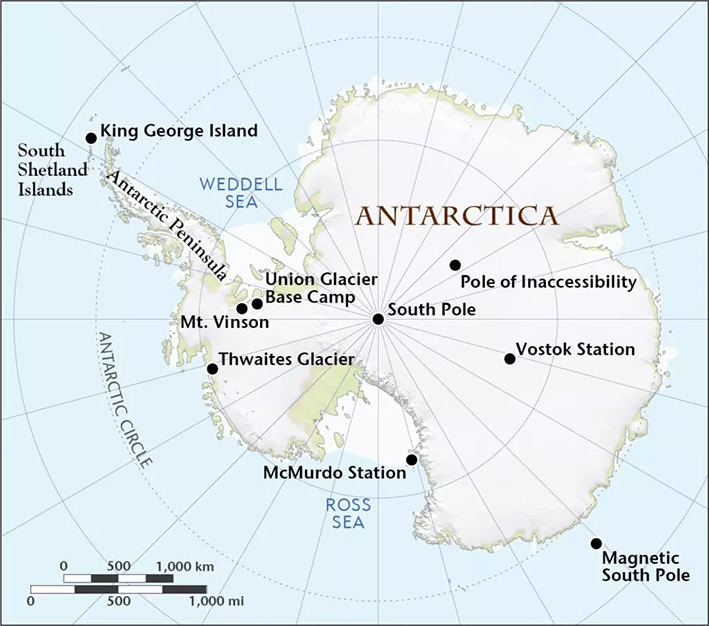Biodiversity & Environment
Marine Protected Areas in Antarctica
- 05 Oct 2021
- 5 min read
Why in News
India has extended its support for protecting the Antarctic environment and for co-sponsoring the proposal of the European Union for designating East Antarctica and the Weddell Sea as Marine Protected Areas (MPAs).
- The Southern Ocean, also called Antarctic Ocean, is a body of salt water covering approximately one-sixteenth of Earth’s total ocean area.
Key Points
- Marine Protected Areas:
- In general terms, a Marine Protected Area (MPA) is a marine area that provides protection for all or part of the natural resources it contains.
- Within an MPA, certain activities are limited, or entirely prohibited, to meet specific conservation, habitat protection, ecosystem monitoring or fisheries management objectives.
- MPAs do not necessarily exclude fishing, research or other human activities; in fact, many MPAs are multi-purpose areas.
- The Commission for the Conservation of Antarctic Marine Living Resources (CCAMLR) has agreed a framework that describes the objectives and requirements for establishing MPAs.
- MPAs in Antarctica:
- Currently, only 5% of the Southern Ocean is protected. MPAs were established in the South Orkney Islands in 2009 and the Ross Sea region in 2016.
- Another three proposals for MPAs are being considered for East Antarctica, the Weddell Sea, and the Antarctic Peninsula.
- MPA proposals are driven by conservation and sustainable utilization principles and adhering to the global cooperation frameworks (such as Sustainable Development Goals, UN Decade of Oceans, Convention on Biodiversity, etc.)
- India is a signatory to these conventions or agreements.
- India urged the Commission for the Conservation of Antarctic Marine Living Resources (CCAMLR) member countries to ensure that India remains associated with the formulation, adaptation and implementation mechanisms of these MPAs in future.
- Need to Establish MPAs:
- The health of the Southern Ocean is driven by changes to the ocean itself - such as:
- Ocean Acidification
- Changes in sea-ice concentration
- Events triggered by climate change such as heat waves and extreme weather.
- These changes affect the marine ecosystem and species of the Antarctic region.
- Further, in response to these impacts, the threat of new and invasive species in the Southern Ocean is growing and endemic marine species like penguins are experiencing a historic die-off.
- Apart from this there is a rapid increase in melting of glaciers in Antarctica . For example, Thwaites Glacier.
- Studies show that MPAs can help vulnerable ecosystems build resilience to climate change by eliminating additional stresses such as fishing.
- In addition, their relatively undisturbed waters provide a natural laboratory for studying how intact marine ecosystems react to a warming and acidifying ocean.
- The health of the Southern Ocean is driven by changes to the ocean itself - such as:
- About Convention on the Conservation of Antarctic Marine Living Resources (CCAMLR):
- CCAMLR is a multilateral response to concerns that unregulated increases in krill catches in the Southern Ocean could be detrimental for Antarctic marine ecosystems particularly for seabirds, seals, whales and fish that depend on krill for food.
- CCAMLR was established by international convention in 1982 with the objective of conserving Antarctic marine life.
- An important feature of CCAMLR is the ecosystem approach to conservation, requiring that the effects on the ecosystem must be taken into account in managing the harvesting of marine resources.
- It’s Secretariat is located in Hobart, Tasmania, Australia.
India’s Antarctic Missions
- India is expanding its infrastructure development in Antarctica.
- The newest base commissioned in 2015 is Bharati.
- India is rebuilding its second station, Maitri, to make it bigger and last for at least 30 more years.
- Dakshin Gangotri, the first Indian base established in 1984, has weakened and become just a supply base.
Antarctic Treaty System
- There are few related agreements that make up the Antarctic treaty system. They are as follows:
- The Protocol on Environmental Protection to the Antarctic Treaty (Madrid, 1991)
- The Convention for the Conservation of Antarctic Seals (CCAS, London, 1972)
- The Convention on the Conservation of Antarctic Marine Living Resources (CCAMLR, Canberra, 1980).







